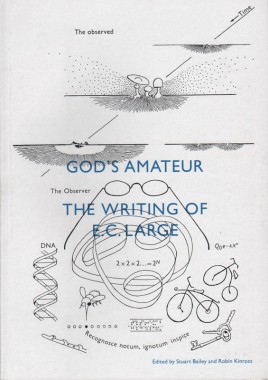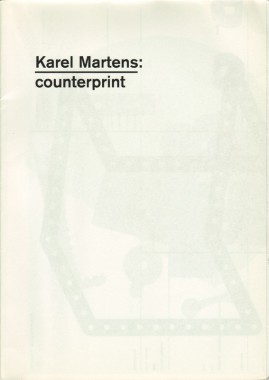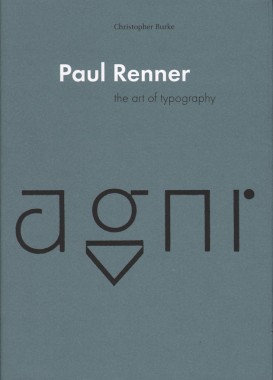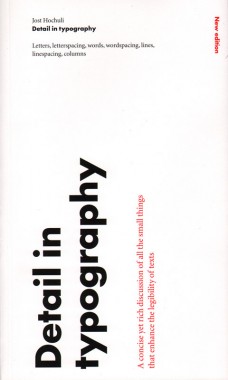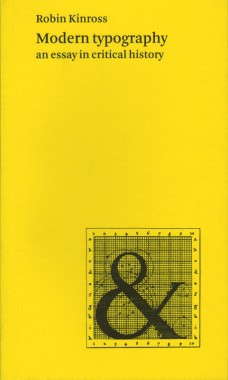God’s amateur: the writing of E.C. Large
Stuart Bailey and Robin Kinross, God’s amateur: the writing of E.C. Large
Softcover, 96 pp., offset 3/1, 170 x 240 mm
Edition of 2000
ISBN 978-0-907259-38-1
Published by Hyphen Press
$20.00 ·
Karel Martens: Counterprint
Karel Martens: Counterprint
Softcover, 32 pp., offset 4/4, 210 x 297 mm
Edition of 4000
ISBN 978-0-907259-25-1
Published by Hyphen Press
$35.00 · out of stock
This is the first publication devoted to Martens’s prints. It is made in association with the printer Lecturis, in Eindhoven, and is produced to the highest quality. Bound in Chinese/Japanese fashion, like the first Martens book, it has a strong quality as an object. The main text in the book is an essay by the English designer Paul Elliman: ‘The world as a printing surface’. Dutch critic and teacher Carel Kuitenbrouwer provides a short introduction. The book is designed by Hans Gremmen, under the supervision of Karel Martens, at the Werkplaats Typografie in Arnhem.
Paul Renner: the art of typography
Christopher Burke, Paul Renner: the art of typography
Softcover, 224 pp., offset 4/1, 170 x 240 mm
Edition of 2000
ISBN 978-0-907259-12-1
Published by Hyphen Press
$35.00 ·
Beginning his career in the thick of the Munich cultural renaissance, Paul Renner worked as a ‘book artist’, applying values he had learnt as a painter to this everyday item of multiple production. An early and prominent member of the Deutscher Werkbund, he was committed to the values of quality in design, always tempered by a certain sobriety of attitude and style. In the 1920s Renner engaged with the radical modernism of that time, briefly in Frankfurt, and then in a more extended phase at the printing school at Munich. Under Renner’s leadership, and with teachers such as Georg Trump and Jan Tschichold, the school produced work of quiet significance. In those years Renner undertook the design of the now ubiquitous typeface Futura. Christopher Burke’s analysis of the design process reveals the characteristic Renner approach: he took up with current tendencies, but through an extended process of finely judged development, helped to deliver a product that has long-lasting quality. In the Nazi seizure of power of 1933, Renner was dismissed from his teaching post — in days recounted here in dramatic detail — and entered a state of ‘inner emigration’. Burke’s account of the Nazi years shows Renner negotiating events with dignity. After 1945, Renner lived in retirement, but entered public discussion of design issues as a voice of experience and sanity.
Paul Renner is a work of discovery. As part of its fresh narrative and analysis, it includes much new illustrative material and the first full bibliography of Renner’s writings.
Detail in typography
Jost Hochuli, Detail in typography
Softcover, 64 pp., offset 2/2, 125 x 210 mm
Edition of 2000
ISBN 978-0-907259-34-3
Published by Hyphen Press
$25.00 ·
Detail in typography, designed by its author, is printed and bound in Switzerland to the best standards. It provides, in its own form and manufacture, a demonstration of how books can be made.
Modern typography: an essay in critical history
Robin Kinross, Modern typography: an essay in critical history
Softcover, 272 pp., offset 4/2, 125 x 210 mm
Edition of 2000
ISBN 978-0-907259-18-3
Published by Hyphen Press
$27.00 · out of stock
This history of typography starts with the early years of the Enlightenment in Europe, around 1700. It was then that typography began to be distinct from printing. Instructional manuals were published, a record of the history of printing began to be constructed, and the direction of the printing processes was taken up by a new figure: the typographer. This starting point gives the discussion a special focus, missing from existing printing and design history. Modern typography is seen as more than just a modernism of style. Rather it is the attempt to work in the spirit of rationality, for clear and open communication. This idea is argued out in the introductory chapter.
The chapters that follow trace the history of typography up to the present moment. Different cultures and countries become the focus for the discussion, as they become significant. In the nineteenth century, Britain provides the main context for modern typography. In the twentieth century, the USA and certain continental European countries are prominent. Kinross provides concise accounts of modernist typography in Central Europe between the wars and in Switzerland in the 1950s and 1960s. Traditionalist typography in the USA, Britain, Germany and the Low Countries is also discussed sympathetically. A concluding chapter considers ‘modern typography’ in the light of the social, political and technical changes of the recent period.
